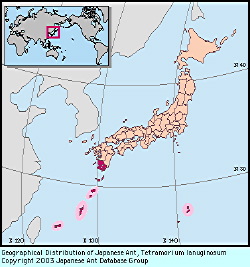
|
species
|
Tetramorium lanuginosum
|
 |
Japanese Name
|
Ikarige-shiwa-ari
|
Original Reference
|
|
Mayr, G. (1870) Neue Formiciden. Verhandlungen der k. k. Zoologisch-Botanischen Gesellschaft in Wien 20: 939-996.
|
Synonym
|
|
Tetramorium obesum striatidens Emery (Emery, 1889) ,
Triglyphothrix lanuginosa Emery (Emery, 1891) ,
Triglyphothrix striatidens Forel (Forel, 1902) ,
Tetramorium lanuginosum Bolton (Bolton, 1985) ,
|
Description
|
|
Total length of workers around 2.5 mm. Body color yellowish brown to reddish brown. Antennae 12-segmented. Anterior margin of clypeus concave. Dorsal outline of mesosoma roundly convex in profile. Petiolar node low, without angulate corners. Head to postpetiole covered with reticulation. Body hairs abundant, some of them bifid or trifid.
|
Remarks
|
|
T. lanuginosum was formerly assigned to the genus Triglyphothrix Forel, which was thought to be distinguished from Tetramorium by the presence of branched (bifid or trifid) body hairs. This character has proved insufficient to sustain the separate status of Triglyphothrix, which was synonymized under Tetramorium by Bolton (1985). In Japan T. lanuginosum is found in somewhat open land, and nests under stones or logs.
|
|

Distribution
|
|
Nansei Is; SE Asia.
|
|
Editor
|
|
Original text by Kazuo Ogata and Keiichi Onoyama. English translation by Kazuo Ogata, edited by Robert W. Taylor.
|
|